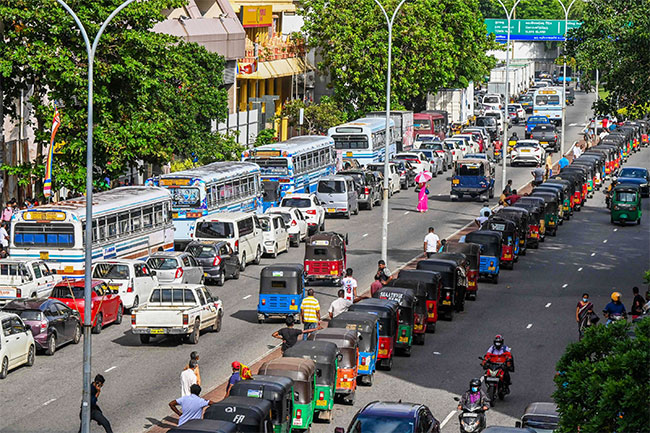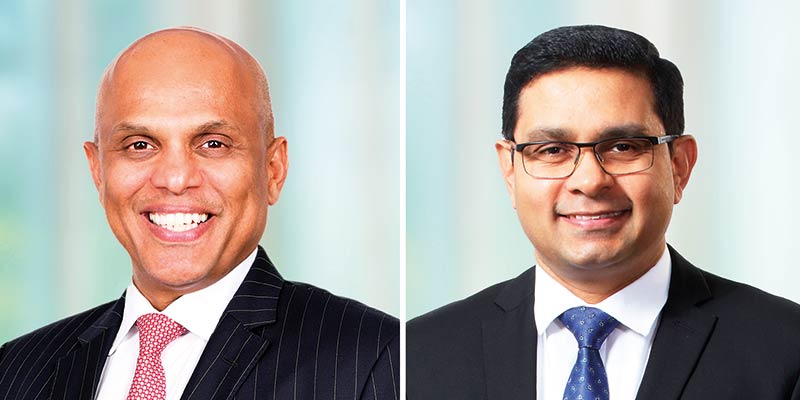Business
Lessons for Colombo from Manila, Bangkok and Hong Kong

Troubled Transportation:
IPS Policy Insights
One of the most critical implications of Sri Lanka’s current economic crisis is the hard hit on the transport sector. The foreign exchange shortage has made importing fuel a major challenge, severely affecting road transportation and further impeding the performance of an already crippled economy. This Policy Insight gives context to the ongoing transportation issues in Sri Lanka and offers medium- and long-term solutions to address the issues, based on lessons learnt from the experiences of Manila, Bangkok and Hong Kong.
Poor Public Transportation
The transportation sector in Sri Lanka absorbs a fair share of petroleum imports to the country and has a very low price elasticity. Despite the many price hikes in 2021, the Ceylon Petroleum Corporation (CPC) sold a total of 3.6 billion litres of petroleum products to the transport sector, which was higher than the average of 3.4 billion litres sold from 2015 onwards. This trend of high demand continues even during the historically high petroleum product price in 2022.
A key reason for this consistently high demand for fuel, particularly in commercial capital of Colombo, is the combination of the overreliance on private transportation and the weak public transportation system. The decline in the public transport sector amidst the above-mentioned consistent high demand for petroleum products in 2021 reflects the inadequate contribution of public transportation towards the transport sector in Sri Lanka. When the demand for petroleum products in 2021 was above the previous period’s average, the operated kilometrage and passenger kilometrage of the public operator Sri Lanka Transport Board (SLTB) declined by 19.7 per cent and 28.4 per cent, respectively, while the corresponding contractions in the private transport sector were 4.4 per cent and 2.2 per cent, respectively. Some part of the decline in public transportation in 2021 can be attributed to COVID-19 related social distancing requirements in travelling. As such, amidst the severe financial crisis with the lack of capacity to import fuel in a timely manner and rising fuel prices due to global and exchange rate pressures, the key solutions to the transportation problem lie in improving the public transportation sector and exploring alternative means of transportation.
Grand Policies and Plans
Sri Lanka has undergone various planning and policy contexts in relation to public transportation. During the 2010-2015 period and its The Emerging Wonder of Asia development framework, the transport sector buzzwords included Bus Rapid Transit (BRT), Light Rail Transit (LRT) and Mass Rapid Transit (MRT). During the 2015-2019 period and its Western Region Megapolis Master Plan, the hype included the Rapid Transit System (RTS), the bus system, the rail system, the road system and the already heard LRT. In the most recent Vistas of Prosperity and Splendour framework, the lingo was peppered with a ‘park and ride’ system, metro rail system, radial and circular road system and the now familiar LRT. Despite varied packaging to cater to the administration’s approach, most of these public transportation-related efforts during the last decade were broadly connected to the National Physical Plan (NPP).
LRT Drama
All previous policy frameworks have recognised the importance of developing an LRT system to ease congestion in transport and commuting but several reasons delayed its implementation. The approval from the Central Environment Authority (CEA) for the LRT was received at the latter part of 2018. There were delays in drafting a framework to regulate the LRT system. Subsequent to fulfilling these, in 2019, the Japan International Cooperation Agency (JICA) expressed willingness to provide a soft loan of USD 1.85 billion out of the total estimated investment of USD 2.2 billion for a LRT connecting Malabe and Fort. This included a 12-year grace period, 40-year payback period, and yen interest rate of 0.1 per cent. By June 2020, Sri Lanka has already signed the agreement with JICA for a loan tranche of USD 270 million, preliminary work had begun, and a contract was signed with a project consultancy firm for USD 130 million. However, in 2020, the project was abruptly halted, the agreement with JICA was reversed and steps were made to seek new proposals from private investors under a Public-Private Partnership (PPP) arrangement.
The ever familiar – yet illusive LRT came to the forefront once again in 2022 when Sri Lanka attempted to woo Japan to extend support during the ongoing economic crisis. Sri Lanka has written to the Japanese Prime Minister requesting financial support while extending “deep regret in scrapping the LRT” project in 2020. Still, it is unclear why the soft loan from Japan was rejected in favour of a PPP and to date, public transportation in Sri Lanka is at an incipient level. When Sri Lanka returns to a position to consider such investments, there should be no room for further policy or planning mistakes or back paddling.
Lessons for Colombo
There are several lessons to be learnt based on the experiences of Metro Manila, Bangkok and Hong Kong which are case studies that Sri Lanka’s transport sector can refer to in its efforts to develop public transportation.
Metro Manila’s experience demonstrates the importance of creating a master plan and sticking to it. One such approach is legalising the transportation plan. This would make it more difficult for a project to be postponed or disbanded when governments change. Another option is to garner support from the government, opposition and the public. If the public supports the initiative, the prospective government or the opposition, has a greater incentive to complete it.
Bangkok’s experience shows how successfully managed PPPs have assisted the development of infrastructure projects without burdening the government. In the case of the Bangkok Mass Transit System (BTS) Sky Train, the government did not provide any funding and as a result, does not face any risk associated with the operation of the light rail. A private company providing 100% of the funding and taking the aggregate risk for a project may be extreme in the Sri Lankan context. But it demonstrates that Sri Lanka can be on the lookout for a private company to finance and potentially fund part of a public transportation project.
Similarly, Hong Kong demonstrates how a private company can successfully run a mass transit system and profit by investing in its train stations and developing rental space. This success was mainly hinged upon Mass Transit Railway (MTR)’s capacity to develop the land and receive the rental income and the conducive environment in Hong Kong to do so. As such, incorporating rental space into transportation investments in Sri Lanka could pave the path for future investments in public transportation to become profitable.
However, a PPP should not be considered a “silver bullet” for Sri Lanka’s public transportation issues. Bangkok’s experience showed that projects developed on a piecemeal basis lack integration and become less efficient. As a result, Bangkok’s Purple Line stops 1 kilometre away from the blue line at a different station. If Sri Lanka is to pursue PPPs for public transportation, an integrated approach where a transportation system is considered as a whole instead of a collection of independent projects in critical.
This Policy Insight is based on the new IPS publication ‘Towards a Developed Urban Transportation System: Lessons for Sri Lanka’ by Bilesha Weeraratne and Chathurga Karunanayake. The complete report can be purchased from the Publications Unit of the IPS located at 100/20, Independence Avenue, Colombo 07 and leading bookshops island wide. For more information, contact 011-2143107 / 077-3737717 or email: publications@ips.lk.
To download more POLICY INSIGHTS from IPS, visit: https://www.ips.lk/publications/policy-insights.
Business
ComBank Loan book up by Rs 121 bn in 9 months, with 44% growth coming in Q3

The Commercial Bank of Ceylon Group has achieved impressive growth at the end of the third quarter of 2024 by banking on judicious portfolio management and continued improvement of its CASA ratio to counteract the impacts of reduced interest income in prevailing market conditions.
Comprising of Sri Lanka’s biggest private sector bank, its subsidiaries and an associate, the Commercial Bank Group has reported net interest income of Rs 88.98 billion for the nine months ended 30th September 2024, an increase of 46.15%, despite declines in interest income and gross income for the period.
With interest rates for customer advances as well as government securities continuing to be lower than in the preceding year, the Group posted gross income of Rs 241.71 billion for the period, down 5.57% over the corresponding nine months of 2023.
Interest income was similarly impacted, reducing by 7.77% to Rs 207.12 billion, but repricing of deposits and a further improvement in the CASA ratio brought interest expenses down by a noteworthy 27.83% to Rs 118.14 billion, enabling healthy growth in net interest income, the Group said in a filing with the Colombo Stock Exchange (CSE).
“The challenge for banks operating in periods of low interest rates is to grow their portfolios while managing margins with timely adjustments,” Commercial Bank Chairman Sharhan Muhseen commented. “Our impeccable record of prudence and fairness along with our demonstrated financial strength continues to drive deposit mobilisation, enabling us to continue to step up lending. The performance for the nine months reviewed flows from these dynamics, underscoring the Group’s expertise and resilience.”
Commercial Bank Managing Director/CEO Sanath Manatunge added that vigilant supervision of the quality of the loans portfolio, equitable and forward-looking management of impairment provisioning and timely repricing of assets and liabilities have underpinned the Group’s nine-month performance and would continue to be the strategy for the future. “Strong, consistent performance even in volatile conditions enables the Bank to continue to accelerate lending, and invest in digital transformation, sustainability and other commitments,” he said.
For the nine months reviewed, the Group reported gross loans and advances of Rs 1.42 trillion, a growth of Rs 121.06 billion or 9.34% since December 2023, at a monthly average of Rs 13.45 billion. Significantly, 44.20% of loan book growth was recorded in the third quarter of the year. Loan book growth over the preceding 12 months was Rs 177.88 billion or 14.36%, averaging Rs 14.82 billion per month.
Deposits increased by 3.66% to Rs 2.23 trillion in the nine months, despite the appreciation of Rupee against the Dollar, reflecting average monthly growth of Rs 8.73 billion, and YoY growth of 9.22%, with monthly average growth of Rs 15.67 billion over the preceding 12 months. Notably, while Rupee deposits grew by more than Rs 120 billion in the review period, the Rupee value of foreign currency deposits reduced by Rs 46.19 billion, due to the appreciation of the Rupee.
Total assets of the Group increased by Rs 108 billion or 4.05% in the nine months to reach Rs 2.76 trillion as at 30th September 2024.
Total operating income of the Group improved by 33.86% to Rs 115.72 billion in the period reviewed. The Group made provisions of Rs 20.02 billion for impairment charges and other losses, a reduction of 22.35% over the figure of Rs 25.78 billion for the corresponding nine months of 2023, which included a provision of Rs 12.57 billion for the third quarter alone. In contrast, impairment charges for the third quarter of 2024 were just Rs 1 billion.
Net operating income for the nine months grew by 57.74% to Rs 95.70 billion. The Group’s success in containing total operating expenses for the period to Rs 36.49 billion – a growth of only 14.12%, enabled it to report operating profit before taxes on financial services of Rs 59.21 billion, an improvement of 106.36%.
Taxes on financial services increased by 141.95% to Rs 8.87 billion, resulting in profit before tax of Rs 50.34 billion for the nine months, an improvement of 101.14%. Income tax for the nine months increased by 83.13% to Rs 18.80 billion, leading to a net profit of Rs 31.54 billion for the first nine months of 2024, representing a growth of 113.61% over the corresponding period of 2023.
Total tax charges of the Group at the end of the third quarter amounted to Rs 27.67 billion, double the Rs 13.93 billion tax charge in respect of the first nine months of the preceding year.
Taken separately, Commercial Bank of Ceylon PLC reported profit before tax of Rs 48.73 billion and profit after tax of Rs 30.38 billion for the nine months reviewed, recording growths of 112.70% and 128.33%, respectively.
Business
IMF team is here to review fiscal data before next disbursement

By Sanath Nanayakkare
A team from the International Monetary Fund (IMF), led by the Senior Mission Chief for Sri Lanka Peter Breuer, will be in Colombo from November 17 to 23.The team will visit the country to conduct the third review of Sri Lanka’s economic reform programme supported by the IMF’s Extended Fund Facility (EFF), an IMF Spokesperson said.
Mr. Breuer will assess Sri Lanka’s economic policies, progress on ongoing reforms, and the implementation of previous agreements with the IMF.Upon successful completion of the review, the IMF is expected to release the next installment of the loan to Sri Lanka.
The IMF has approved a 2.9 billion dollar Extended Fund Facility for Sri Lanka over a 48-month period in tranches to help its economy recover from the economic crisis.
It is expected that the customary end-of-mission statement of the IMF will be made to the Sri Lankan media after the mission has given its formal feedback to the authorities.Analysts say it would be vital to see what recommendations the IMF would give the authorities if they observed any revenue shortfalls against the given benchmarks.
Business
Chinese Dragon Café marks 82nd anniversary

Chinese Dragon Café, the Chinese restaurant chain, recently celebrated its 82nd anniversary. The restaurant was founded in 1942 in Bambalapitiya by a Chinese couple who brought authentic Chinese cuisine to Sri Lanka, quickly gaining popularity among locals.
For over eight decades, Chinese Dragon Café has catered to Sri Lankan consumers, offering more than 200 delicious food recipes. From its beginnings as a single restaurant, it has grown into Sri Lanka’s first Chinese cuisine chain, now operating eight outlets across the country, with locations in Bambalapitiya, Mount Lavinia, Rajagiriya, Pelawatta, Wattala, Kandana, Kaduwela, and Nugegoda.
-

 News7 days ago
News7 days agoHarin drags Messi into poll mess
-

 Life style2 days ago
Life style2 days agoKing of coconuts heads for a golden future
-

 Features6 days ago
Features6 days agoAdani’s ‘Power’ in Sri Lanka
-

 Latest News3 days ago
Latest News3 days agoColombo district preferential votes announced
-

 Editorial7 days ago
Editorial7 days ago‘Political prisoners’
-

 News3 days ago
News3 days agoPresident warns his party: “We will fail if we view power as an entitlement to do as we please”
-

 Features7 days ago
Features7 days agoEducation, democracy and unravelling liberal order
-

 Opinion7 days ago
Opinion7 days agoAre cracks already showing ?











